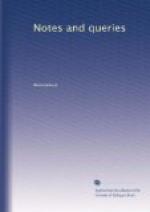Carlisle.
Collar of Esses (Vol. ii., p. 393.).—With reference to the suggestion in No. 54., to give examples of effigies bearing the collar, I beg to mention those at Northleigh Church, Oxon. The following extract is from the Guide to Neighbourhood of Oxford:—
“In Northleigh church, beneath an arch between the chancel and a chapel, is a fine perpendicular tomb, with two recumbent figures in alabaster,—a knight in armour, with the Collar of SS; the lady with a rich turban and reticulated head-dress, and also with the Collar of SS. The figures are Lord and Lady Wilmot; and attached to the monument are two small figures of angels holding shields of arms; on one is a spread eagle, on the other three cockle shells, with an engrailed band.”
JASPER.
Filthy Gingram (Vol. ii., p. 467.).—The name “toad-flax” is evidently put by mistake, in Owen’s Dictionary, for “toad-stool,” a fungus, the Agaricus virosus of Linnaeus. The common name in the North of England is “poisonous toad-stool.” It is a virulent poison. See * 248. 407, 408., in Sowerby’s English Fungi.
D.2.
Toad-flax, the yellow Antirrhinum, certainly does stink.
C.B.
The Life and Death of Clancie, by E.S. (Vol. ii., p. 375.).—There is a copy in the Bodleian Library.
J.O.H.
“Rab. Surdam” (Vol. ii., p. 493.).—EDINENSIS. gives the above as the inscription on a tomb-stone, and requests an explanation. It is very probable that the stone-cutter made a mistake, and cut “Rab. Surdam” instead of “Rap. Surum,” which would be a contraction for “Rapax Suorum,” alluding to Death or the Grave. It seems {43} impossible to extract a meaning, from “Rab. Surdam” by any stretch of Latinity.
G.F.G.
Edinburgh.
"Fronte Capillata,” &c. (Vol. iii., p. 8.).—The hexameter cited vol. iii., p. 8., and rightly interpreted by E.H.A., is taken (with the slight alteration of est for the original es) from “Occasio: Drama, P. Joannis David, Soc. Jesu Sacerd. Antv. MDCV.,” appended to that writer’s Occasio, Arrepta, Neglecta; in which the same implied moral is expressed, with this variation:
“Fronte capillitium gerit, ast glabrum occiput illi.”
G.A.S.
This verse is alluded to by Lord Bacon in his Essay on Delays:
“Occasion (as it is in the common verse) turneth a bald noddle after she hath presented her locks in front, and no hold taken; or, at least, turneth the handle of the bottle first to be received, and after the belly, which is hard to clasp.”




